The AMD Radeon R9 290X Review
by Ryan Smith on October 24, 2013 12:01 AM EST- Posted in
- GPUs
- AMD
- Radeon
- Hawaii
- Radeon 200
Bioshock Infinite
Bioshock Infinite is Irrational Games’ latest entry in the Bioshock franchise. Though it’s based on Unreal Engine 3 – making it our obligatory UE3 game – Irrational had added a number of effects that make the game rather GPU-intensive on its highest settings. As an added bonus it includes a built-in benchmark composed of several scenes, a rarity for UE3 engine games, so we can easily get a good representation of what Bioshock’s performance is like.
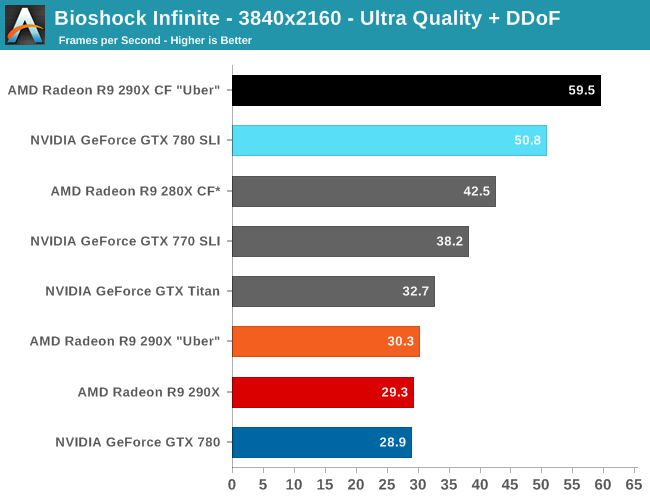

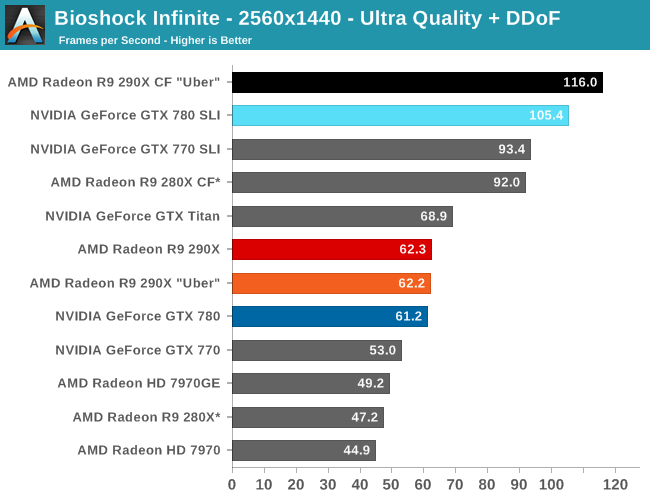
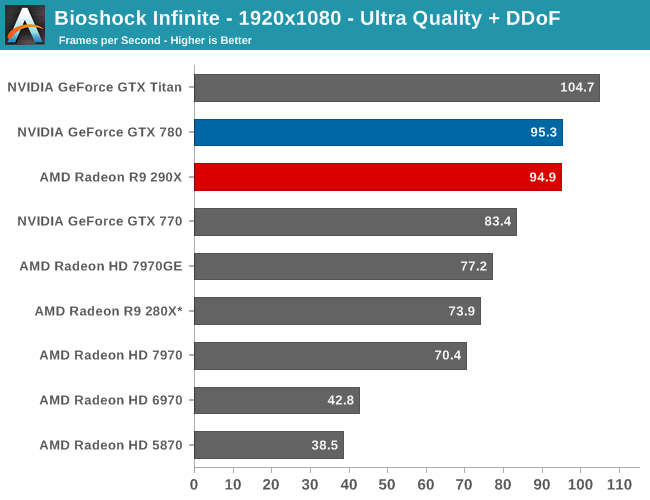
The first of the games AMD allowed us to publish results for, Bioshock is actually a straight up brawl between the 290X and the GTX 780 at 2560. The 290X’s performance advantage here is just 2%, much smaller than the earlier leads it enjoyed and essentially leaving the two cards tied, which also makes this one of the few games that 290X can’t match GTX Titan. At 2560 everything 290X/GTX 780 class or better can beat 60fps despite the heavy computational load of the depth of field effect, so for AMD 290X is the first single-GPU card from them that can pull this off.
Meanwhile at 4K things end up being rather split depending on the resolution we’re looking at. At Ultra quality the 290X and GTX 780 are again tied, but neither is above 30fps. Drop down to Medium quality however and we get framerates above 60fps again, while at the same time the 290X finally pulls away from the GTX 780, beating it by 14% and even edging out GTX Titan. Like so many games we’re looking at today the loss in quality cannot justify the higher resolution, in our opinion, but it presents another scenario where 290X demonstrates superior 4K performance.
For no-compromises 4K gaming we once again turn our gaze towards the 290X CF and GTX 780 SLI, which has AMD doing very well for themselves. While AMD and NVIDIA are nearly tied at the single GPU level – keep in mind we’re in uber mode for CF, so the uber 290X has a slight performance edge in single GPU mode – with multiple GPUs in play AMD sees better scaling from AFR and consequently better overall performance. At 95% the 290X achieves a nearly perfect scaling factor here, while the GTX 780 SLI achieves only 65%. Curiously this is better for AMD and worse for NVIDIA than the scaling factors we see at 2560, which are 86% and 72% respectively.
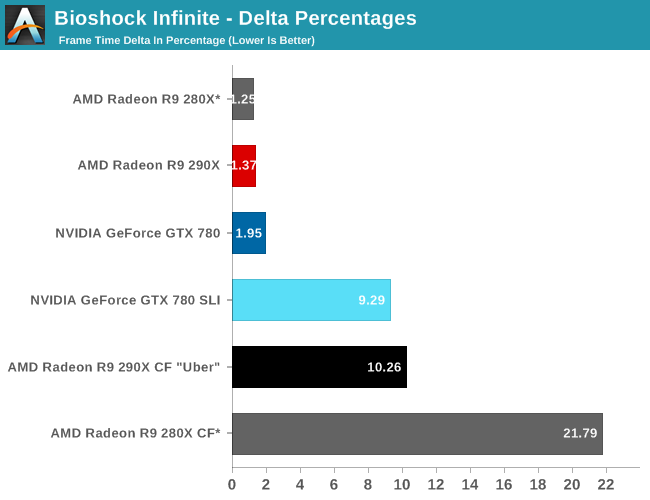

Moving on to our FCAT measurements, it’s interesting to see just how greatly improved the frame pacing is for the 290X versus the 280X, even with the frame pacing fixes in for the 280X. Whereas the 280X has deltas in excess of 21%, the 290X brings those deltas down to 10%, better than halving the variance in this game. Consequently the frame time consistency we’re seeing goes from being acceptable but measurably worse than NVIDIA’s consistency to essentially equal. In fact 10% is outright stunning for a multi-GPU setup, as we rarely achieve frame rates this consistent on those setups.
Finally for 4K gaming our variance increases a bit, but not immensely so. Despite the heavier rendering workload and greater demands on moving these large frames around, the delta percentages keep to 13%.


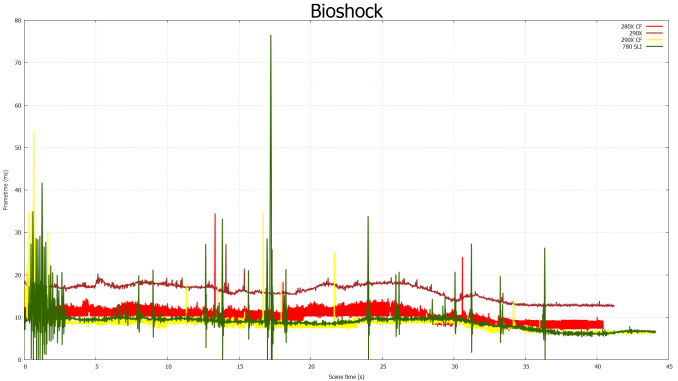









396 Comments
View All Comments
SolMiester - Monday, October 28, 2013 - link
So you can OC a 780 on stock, but not the 290x to sustain the OC, which means 780 wins!, especially after the price drop to $500!, oh dear AMD 290x just went from hero to zero...TheJian - Friday, October 25, 2013 - link
I gave links and named the games previously...See my post. At 1080p 780 trades blows depending on the games. Considering 98.75% of us are 1920x1200 or less, that is important and you get 3 AAA games with 780, on top of the fact that it's using far less watts, less noise and less heat. A simple drop in price of $50-100 and 780 seems like a no brainer to me (disregarding the 780TI which should keep the same price as now I'd guess). Granted Titan needs a dunk in price now too, which I'm sure will come or they'll just replace it with a full SMX up-clocked titan to keep that price. I'm guessing old titan just died as 780TI will likely beat it in nearly everything if the rumored clock speed and extra smx are true. They will have to release a new titan ULTRA or something with another smx or up the mhz to 1ghz or something. OR hopefully BOTH.I'm guessing it's easier to just up the 100mhz or put it to 1ghz as surely manufacturing has gotten them to where all will do this now, more than having all SMX's defect free. Then again if you have a bad SMX just turn a few more off and it's a 780TI anyway. They've had 8 months to either pile up cherry picked ones, or just improve totally anyway so more can do this easily. Clearly 780ti was just waiting in the wings already. They were just waiting to see 290x perf and estimates.
eddieveenstra - Sunday, October 27, 2013 - link
Titan died when 780gtx entered the room at 600 Euro. I'm betting Nvidia only brings a 780gtx ti and that's it. Titan goes EOL.anubis44 - Thursday, October 24, 2013 - link
This is the reference card. It's not loud unless you set it to 'Uber' mode, and even then, HardOCP thought the max fan speed should be set to 100% rather than 55%. Imagine how quiet an Asus Direct CUIII or Gigabyte Windforce or Sapphire Toxic custom cooled R9 290x will be.Crossfire and frame pacing all working, and R9 290X crushes Titan in 4K gaming (read HardOCP's review of this 4K section), all while costing $100 less than GTX780, and the R9 280X (7970) is priced at $299, and the R9 270X (7870) is now going for $180, and now Mantle API could be the next 3dfx Glide, and boost all 7000-series cards and higher dramatically for free...
It's like AMD just pulled out a light sabre and cut nVidia right in half while Jsen Hsun just stares dumbly at them in disbelief. He should have merged nVidia with AMD when he had the chance. Could be too late now.
Shark321 - Thursday, October 24, 2013 - link
There will be no custom cooling solution for the time being. It's the loudest card ever released. Twice as loud as 780/Titan in BF3 after 10 minutes of playing. Also Nvidia will bringt the 780Ti in 3 weeks, a faster cart at a comparable price, but quiet. AMD releases the 290x one year after NVidia, 2 years after NVidias tipeout. Nvidia will be able to counter this with a wink.just4U - Thursday, October 24, 2013 - link
Shark Writes: "It's the loudest card ever released."Guess you weren't around for the Geforce5...
HisDivineOrder - Thursday, October 24, 2013 - link
The FX5800 is not ever dead. Not if we remember the shrill sound of its fans......or if the sound burned itself into our brains for all time.
Samus - Friday, October 25, 2013 - link
I think the 65nm GeForce 280 takes the cake for loudest card ever made. It was the first card with a blower.ninjaquick - Thursday, October 24, 2013 - link
lol, the Ti can only do so much, there is no smaller node for either company to jump to, not until March for enough shipments to have stock for sales. The 290X just proves AMD's GCN design is a keeper. It is getting massively throttled by heat and still manages to pull a slight lead over the titan, at sometimes 15% lower clocks than reference. AMD needed a brand for this release season, and they have it.Both Nvidia and AMD are jumping to the next node in 2014. Nvidia will not release Maxwell on the current node. And there is no other node they would invest in going to.
HisDivineOrder - Thursday, October 24, 2013 - link
The Ti could theoretically open up all the disabled parts of the current GK110 part. Doing that, who knows what might happen? We've yet to see a fully enabled GK110. I suspect that might eat away some of the Titan's efficiency advantage, though.